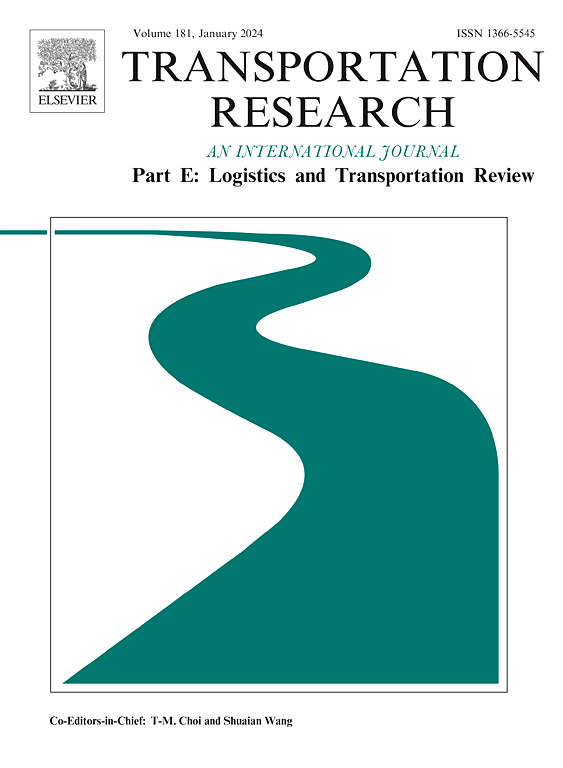Constructing a routable multimodal, multi-cost, time-dependent network model with all emerging mobility options: Methodology and case studies
IF 8.3
1区 工程技术
Q1 ECONOMICS
Transportation Research Part E-Logistics and Transportation Review
Pub Date : 2024-09-25
DOI:10.1016/j.tre.2024.103757
引用次数: 0
Abstract
Cities aiming to improve their transportation networks are integrating emerging mobility options at a rapid pace. These modes provide commuters with greater flexibility to construct more convenient trips and reach a larger set of essential service destinations. A few open-source tools allow planners to conduct multimodal routing analysis in time-dependent networks, but they do not sufficiently capture the full set of travel mode combinations and disutility factors perceived by individual travelers. To this end, we introduce NOMAD: Network Optimization for Multimodal Accessibility Decision-making. NOMAD integrates the personal vehicle, transportation network company, carshare, public transit, personal bike, bikeshare, scooter, walking, and feeder micro-transit modes into a unified routable network model. A generalized travel cost function incorporates the following disutility factors: monetary cost, day-to-day mean travel time, (un)reliability as represented by day-to-day 95th percentile travel time, crash risk, and physical discomfort. The proposed open-source tool can be used to create multimodal travel cost matrices, which may immediately serve as an input for accessibility analysis and other policy decisions related to emerging mobility options. This paper develops the network model that forms the basis of NOMAD and demonstrates four use cases in Pittsburgh, PA.
构建一个可路由的多模式、多成本、随时间变化的网络模型,其中包含所有新出现的流动选项:方法与案例研究
旨在改善交通网络的城市正在快速整合新兴的交通方式。这些模式为通勤者提供了更大的灵活性,让他们可以构建更便捷的出行方式,到达更多的基本服务目的地。一些开源工具允许规划者在随时间变化的网络中进行多模式路由分析,但这些工具并不能充分捕捉旅行者所感知到的全部旅行模式组合和不便因素。为此,我们引入了 NOMAD:多式联运可达性决策网络优化。NOMAD 将个人汽车、交通网络公司、汽车共享、公共交通、个人自行车、自行车共享、滑板车、步行和接驳微型交通模式整合到一个统一的可路由网络模型中。广义的出行成本函数包含以下效用因素:货币成本、日均出行时间、以日均第 95 百分位出行时间表示的(不)可靠性、碰撞风险和身体不适。提议的开源工具可用于创建多式联运出行成本矩阵,该矩阵可立即作为无障碍分析和与新兴交通选择相关的其他政策决策的输入。本文开发了构成 NOMAD 基础的网络模型,并演示了宾夕法尼亚州匹兹堡市的四个使用案例。
本文章由计算机程序翻译,如有差异,请以英文原文为准。
求助全文
约1分钟内获得全文
求助全文
来源期刊
CiteScore
16.20
自引率
16.00%
发文量
285
审稿时长
62 days
期刊介绍:
Transportation Research Part E: Logistics and Transportation Review is a reputable journal that publishes high-quality articles covering a wide range of topics in the field of logistics and transportation research. The journal welcomes submissions on various subjects, including transport economics, transport infrastructure and investment appraisal, evaluation of public policies related to transportation, empirical and analytical studies of logistics management practices and performance, logistics and operations models, and logistics and supply chain management.
Part E aims to provide informative and well-researched articles that contribute to the understanding and advancement of the field. The content of the journal is complementary to other prestigious journals in transportation research, such as Transportation Research Part A: Policy and Practice, Part B: Methodological, Part C: Emerging Technologies, Part D: Transport and Environment, and Part F: Traffic Psychology and Behaviour. Together, these journals form a comprehensive and cohesive reference for current research in transportation science.

 求助内容:
求助内容: 应助结果提醒方式:
应助结果提醒方式:


